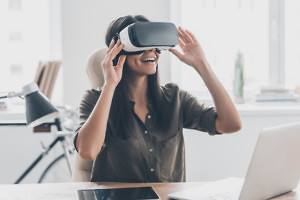
The term “virtual reality” has been around for a long time; used extensively as a plot device in such movies as The Matrix and Lawnmower Man and in a range of video game headsets like the Sega VR. Virtual reality has reached the masses in recent years in the form of headsets paired with smartphones that display stereoscopic head-mounted displays along with stereo sound and head motion tracking sensors immersing you in a realistic 360-degree artificial environment. Sometimes you don’t even need a headset, you can just hold the device and physically turn your body to see it from all angles. Other uses for this new form of VR include medical students observing surgical operations, movies releasing virtual reality trailers, and lawyers using it in court so the jury can see the crime scene for themselves. The VR industry is worth $1 billion as of 2016 and is expected to reach $30 billion by 2020. More recent popular applications include the 2016 launch of Pokémon Go, and brands like Coca-Cola and McDonald’s using VR for marketing campaigns. Want to get in on the action to promote your brand? Here are four reasons why VR may be the marketing tool you need:
- People will remember it
Virtual reality works because of Presence, meaning the digital environment seems completely real and you feel present within it. You place them in any setting imaginable. It’s like mind control. Consumers are more likely to remember a VR campaign because they are so rare and unique. This kind of experience has not been possible before. How could they forget?
- Try It Before You Buy It
You know how you can try on clothes at the store before you buy it? Now you could see how it looks on you without even wearing it. Imagine if you could see a piece of furniture in your house before you decide to purchase, or see a 3D rendering of what your remodeled room will look like, or even tour a new house without actually visiting it. Lowes is experimenting with this type of virtual home design, calling it Holorooms. And fashion retailers like Rebecca Minkoff have equipped “magic mirrors” in fitting rooms. These tools keep consumers interacting with the brand for longer, which makes them more likely to buy something.
- Easy to Use
Producing VR content is highly technical, however, experiencing it only requires a smart device and headset like Google Cardboard or Oculus Rift. You don’t need a million dollar machine or NASA technology. You can download a series of virtual reality apps to your phone, insert it on the headset, and get lost in the digital world. Social media are jumping at the chance to provide VR platforms. Facebook recently launched a beta version of Facebook Spaces, specific to Oculus Rift users, where your virtual clone can interact with others in a digital world as if you’re meeting face to face. For other users, virtual reality expert Sarah Hill from StoryUp says to put your content on Facebook 360, Littlstar, and YouTube 360 to reach a wider audience. These platforms don’t require a headset and give users the option to move the camera angle with their mouse instead.
- Proven to be Effective
Big-name brands have already launched virtual reality campaigns with very high success rates. McDonald’s tested VR at its locations in Sweden, where the Happy Meal boxes could be folded into VR goggles. Then they could download an exclusive app, insert the phone into the “Happy Goggles,” and virtually slide down a ski slope. During the 2015 Christmas season, Coca-Cola came out with a virtual reality sleigh ride in Poland specifically for Oculus Rift where thousands of people got to look through Santa’s eyes.
Movies and television shows release promotional VR videos too. Recently, the movie It launched a virtual reality experience on social media where viewers would face Pennywise the clown from Georgie’s perspective. Last year, Rogue One: A Star Wars Story had a video promo in which users felt like they were flying an X-Wing during battle. Even Game of Thrones got in on the action by virtually placing fans inside familiar scenes, allowing them to be part of the show. The New York Times released a virtual reality app that included a short 360-degree documentary about families losing their homes due to war. It received 50,000 downloads and 1.5 million views. You don’t just watch it, you experience it.

